Abstract
A noninvasive method allowing measurements of the propeptides of collagen type III (PIIINP) and type I (PICP) in ulcer washings was developed. The response to topical human growth hormone was examined. Fourteen patients with venous ulcers were treated sequentially with human growth hormone (0.1, 0.25, and 1 IU/cm2/day), each dose for 1 week, followed by 1 week washout. On alternate days, three and two times during treatment and washout periods, respectively, the ulcers were washed and incubated for 30 minutes with sterile water. No changes in healing rates in relation to growth hormone application were observed. In contrast, PIIINP increased significantly to 168% (154% to 184%) (mean, 95% confidence interval) and 195% (179% to 218%) 5 and 9 days, respectively, after start of treatment, (p < 0.01). Propeptides of collagen type I reached a significant increase, to 196% (172% to 232%), in the fourth week, (p < 0.01). The areas under the curves of PICP and PIIINP correlated significantly with the healing rates (r = 0.57, p = 0.04; and r = 0.64, p = 0.01, respectively). The authors conclude that propeptide measurements may be useful markers of healing in clinical studies.
Full text
PDF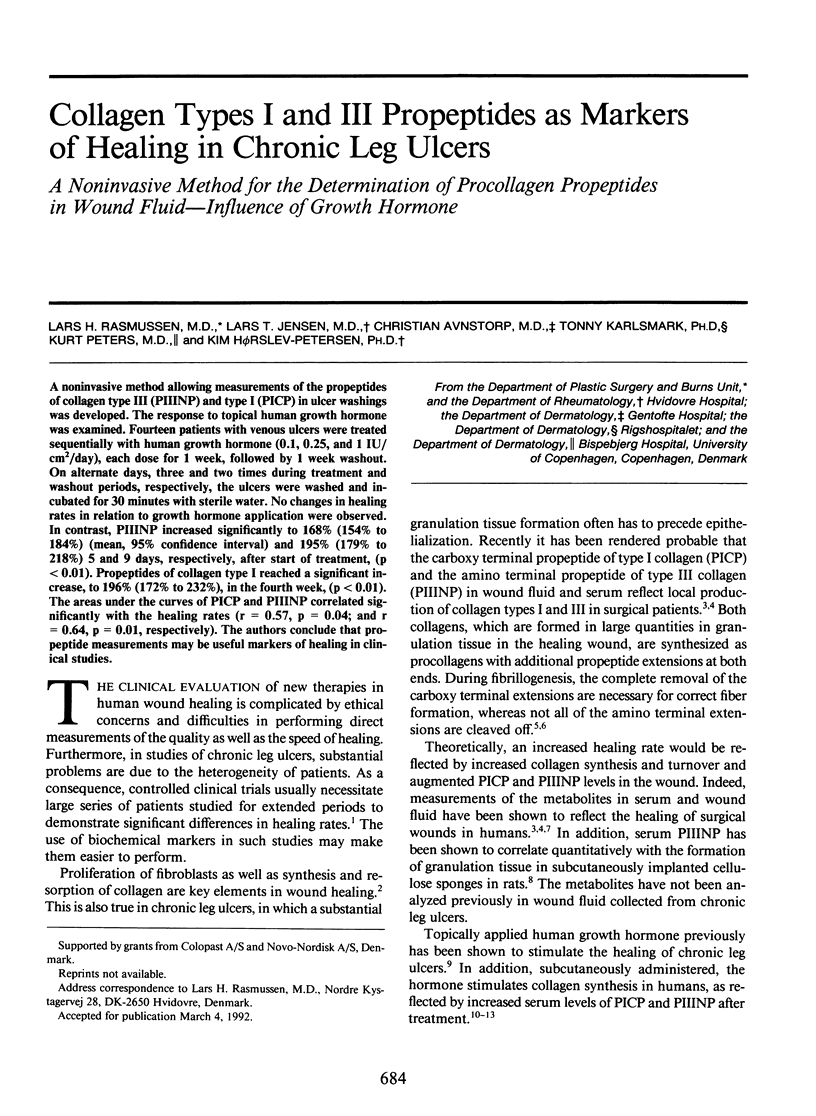

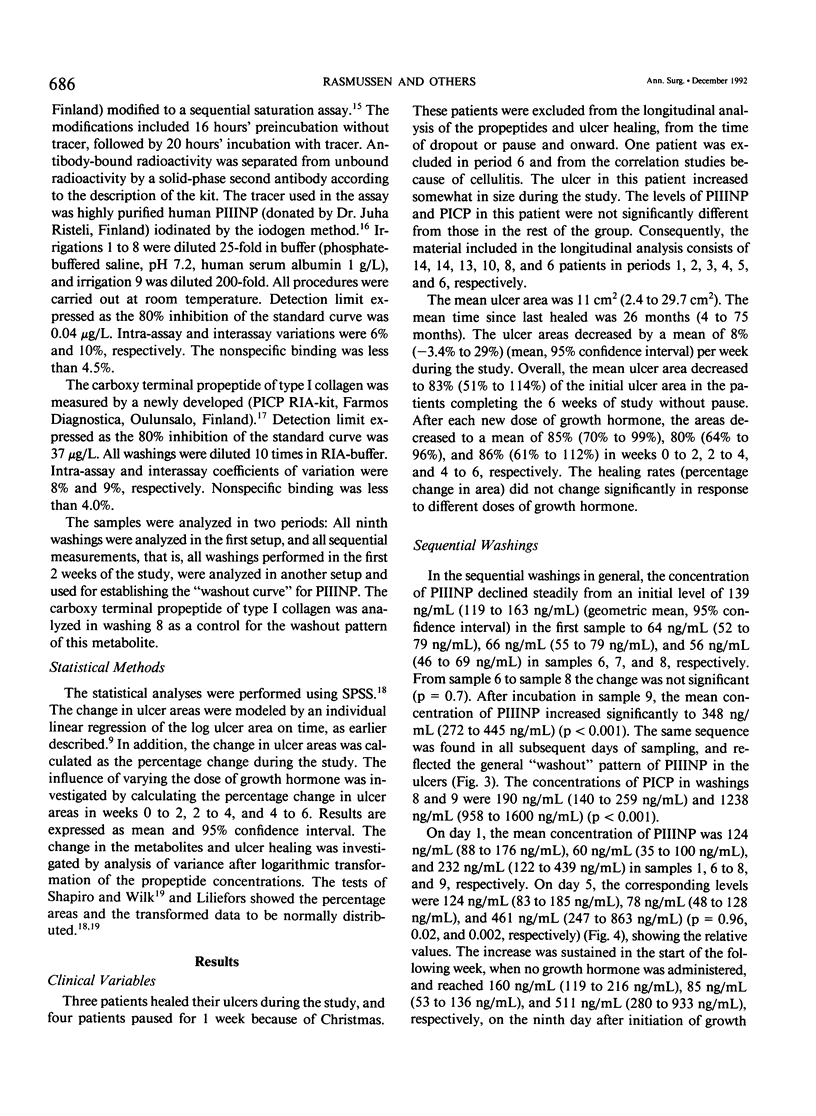
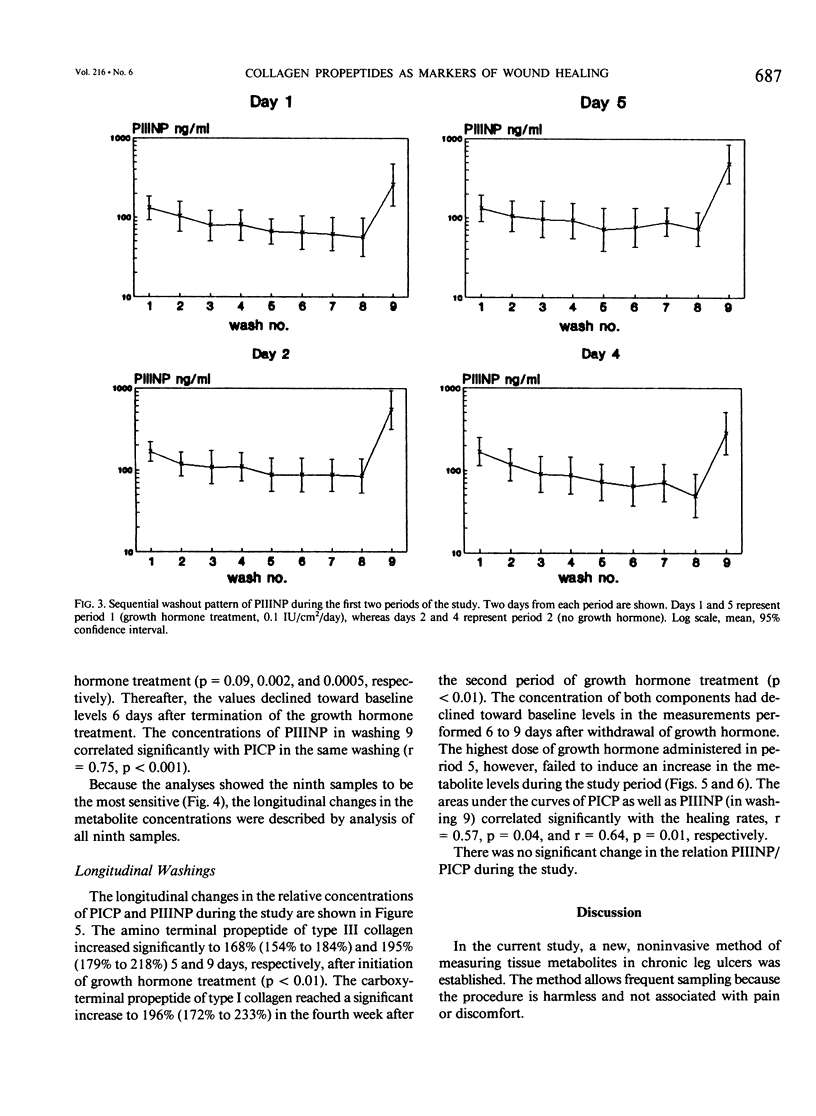
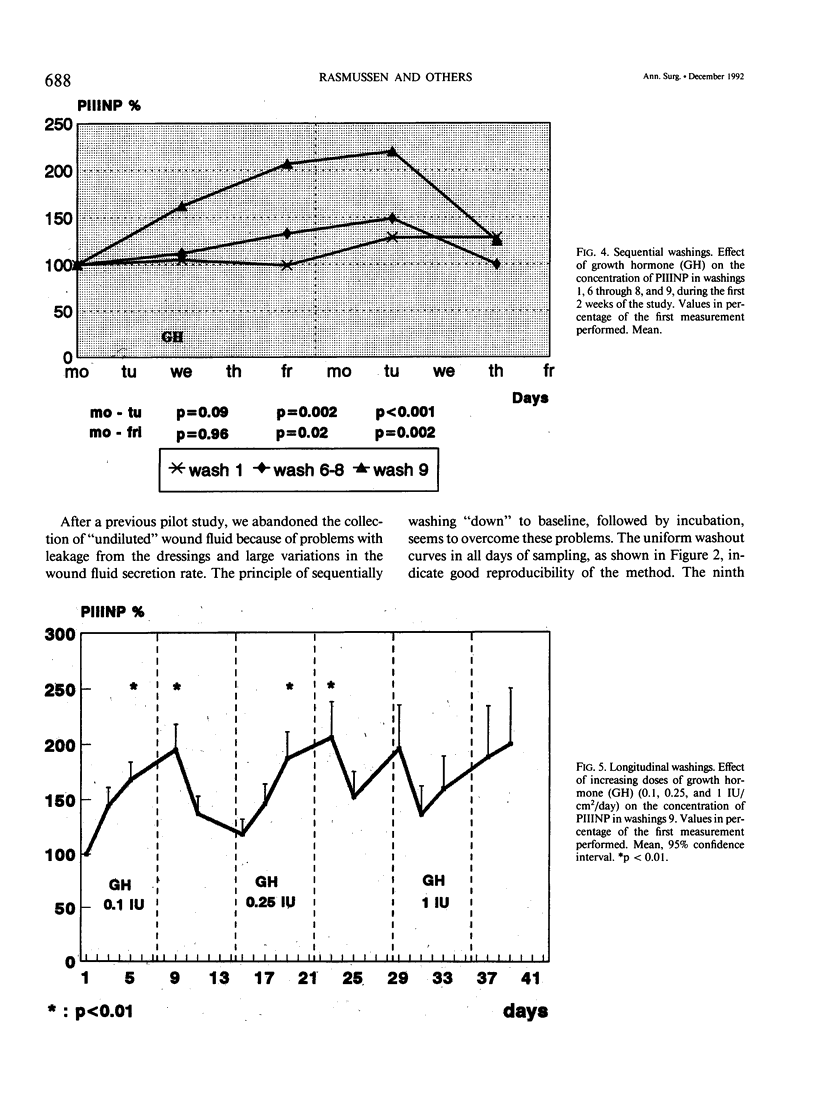
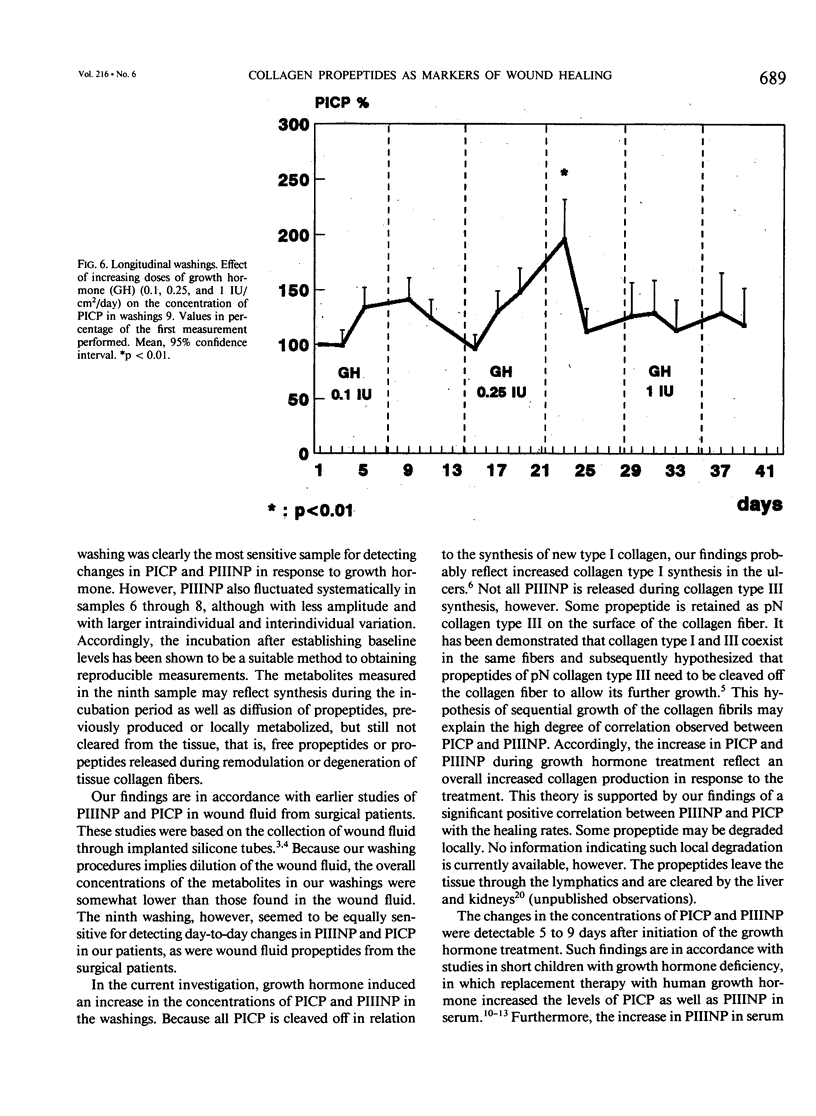
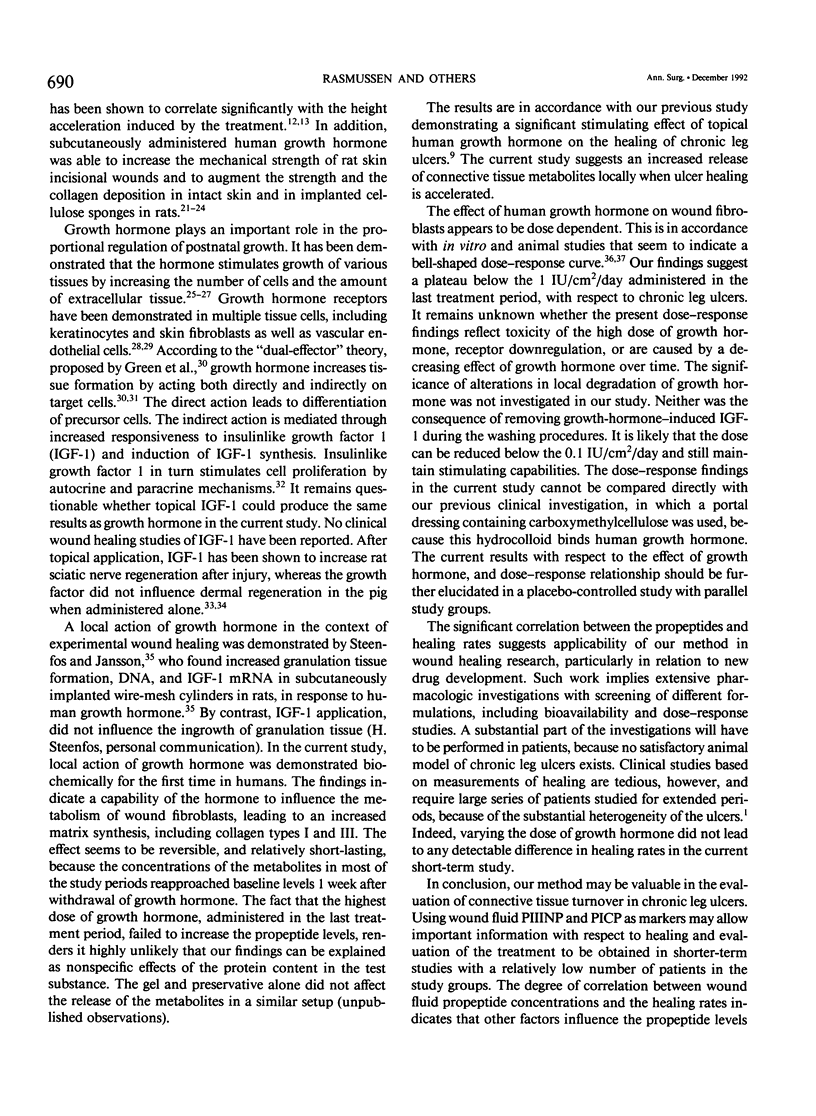
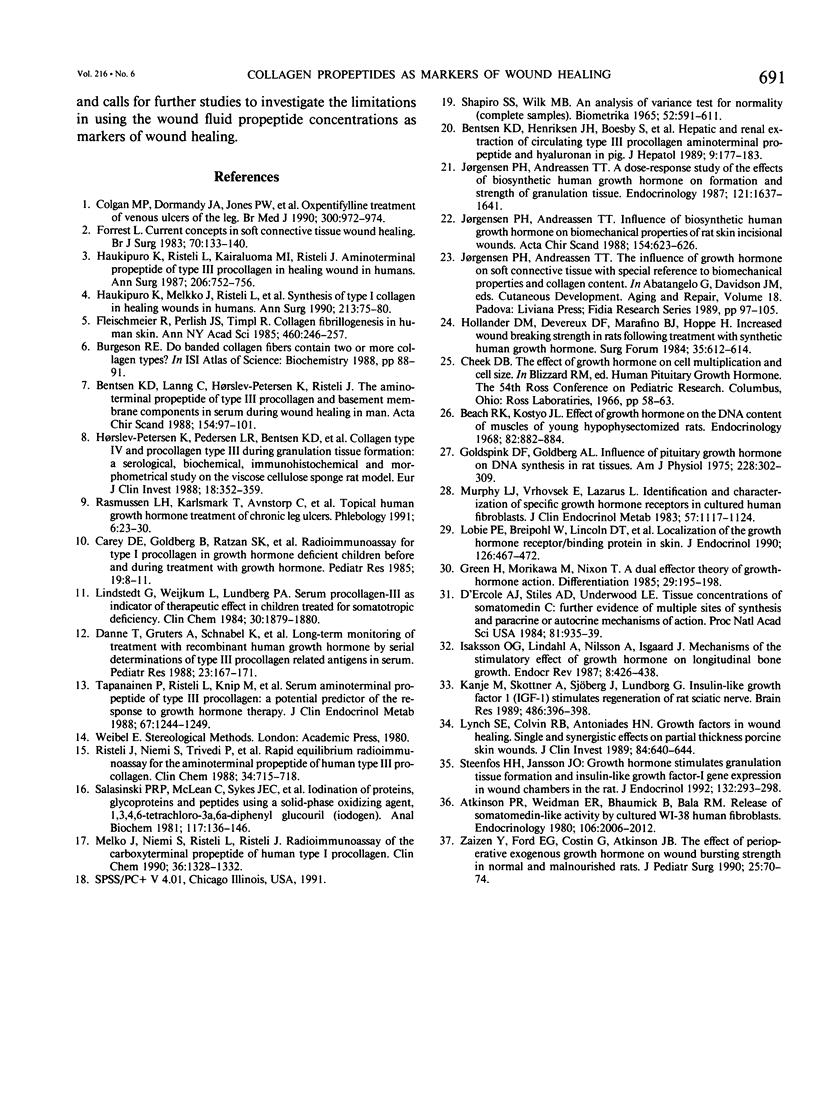
Images in this article
Selected References
These references are in PubMed. This may not be the complete list of references from this article.
- Atkison P. R., Weidman E. R., Bhaumick B., Bala R. M. Release of somatomedin-like activity by cultured WI-38 human fibroblasts. Endocrinology. 1980 Jun;106(6):2006–2012. doi: 10.1210/endo-106-6-2006. [DOI] [PubMed] [Google Scholar]
- Beach R. K., Kostyo J. L. Effect of growth hormone on the DNA content of muscles of young hypophysectomized rats. Endocrinology. 1968 Apr;82(4):882–884. doi: 10.1210/endo-82-4-882. [DOI] [PubMed] [Google Scholar]
- Bentsen K. D., Henriksen J. H., Boesby S., Hørslev-Petersen K., Lorenzen I. Hepatic and renal extraction of circulating type III procollagen amino-terminal propeptide and hyaluronan in pig. J Hepatol. 1989 Sep;9(2):177–183. doi: 10.1016/0168-8278(89)90048-2. [DOI] [PubMed] [Google Scholar]
- Bentsen K. D., Lanng C., Hørslev-Petersen K., Risteli J. The aminoterminal propeptide of type III procollagen and basement membrane components in serum during wound healing in man. Acta Chir Scand. 1988 Feb;154(2):97–101. [PubMed] [Google Scholar]
- Carey D. E., Goldberg B., Ratzan S. K., Rubin K. R., Rowe D. W. Radioimmunoassay for type I procollagen in growth hormone-deficient children before and during treatment with growth hormone. Pediatr Res. 1985 Jan;19(1):8–11. doi: 10.1203/00006450-198501000-00003. [DOI] [PubMed] [Google Scholar]
- Colgan M. P., Dormandy J. A., Jones P. W., Schraibman I. G., Shanik D. G., Young R. A. Oxpentifylline treatment of venous ulcers of the leg. BMJ. 1990 Apr 14;300(6730):972–975. doi: 10.1136/bmj.300.6730.972. [DOI] [PMC free article] [PubMed] [Google Scholar]
- D'Ercole A. J., Stiles A. D., Underwood L. E. Tissue concentrations of somatomedin C: further evidence for multiple sites of synthesis and paracrine or autocrine mechanisms of action. Proc Natl Acad Sci U S A. 1984 Feb;81(3):935–939. doi: 10.1073/pnas.81.3.935. [DOI] [PMC free article] [PubMed] [Google Scholar]
- Danne T., Grüters A., Schnabel K., Burger W., L'Allemand D., Enders I., Helge H., Weber B. Long-term monitoring of treatment with recombinant human growth hormone by serial determinations of type III procollagen-related antigens in serum. Pediatr Res. 1988 Feb;23(2):167–171. doi: 10.1203/00006450-198802000-00008. [DOI] [PubMed] [Google Scholar]
- Fleischmajer R., Perlish J. S., Timpl R. Collagen fibrillogenesis in human skin. Ann N Y Acad Sci. 1985;460:246–257. doi: 10.1111/j.1749-6632.1985.tb51172.x. [DOI] [PubMed] [Google Scholar]
- Forrest L. Current concepts in soft connective tissue wound healing. Br J Surg. 1983 Mar;70(3):133–140. doi: 10.1002/bjs.1800700302. [DOI] [PubMed] [Google Scholar]
- Goldspink D. F., Goldberg A. L. Influence of pituitary growth hormone on DNA synthesis in rat tissues. Am J Physiol. 1975 Jan;228(1):302–309. doi: 10.1152/ajplegacy.1975.228.1.302. [DOI] [PubMed] [Google Scholar]
- Green H., Morikawa M., Nixon T. A dual effector theory of growth-hormone action. Differentiation. 1985;29(3):195–198. doi: 10.1111/j.1432-0436.1985.tb00316.x. [DOI] [PubMed] [Google Scholar]
- Haukipuro K., Melkko J., Risteli L., Kairaluoma M., Risteli J. Synthesis of type I collagen in healing wounds in humans. Ann Surg. 1991 Jan;213(1):75–80. doi: 10.1097/00000658-199101000-00013. [DOI] [PMC free article] [PubMed] [Google Scholar]
- Haukipuro K., Risteli L., Kairaluoma M. I., Risteli J. Aminoterminal propeptide of type III procollagen in healing wound in humans. Ann Surg. 1987 Dec;206(6):752–756. doi: 10.1097/00000658-198712000-00011. [DOI] [PMC free article] [PubMed] [Google Scholar]
- Hørslev-Petersen K., Pedersen L. R., Bentsen K. D., Brocks D., Garbarsch C., Kim K. Y., Hahn E. G., Schuppan D., Lorenzen I. Collagen type IV and procollagen type III during granulation tissue formation: a serological, biochemical, immunohistochemical and morphometrical study on the viscose cellulose sponge rat model. Eur J Clin Invest. 1988 Aug;18(4):352–359. doi: 10.1111/j.1365-2362.1988.tb01023.x. [DOI] [PubMed] [Google Scholar]
- Isaksson O. G., Lindahl A., Nilsson A., Isgaard J. Mechanism of the stimulatory effect of growth hormone on longitudinal bone growth. Endocr Rev. 1987 Nov;8(4):426–438. doi: 10.1210/edrv-8-4-426. [DOI] [PubMed] [Google Scholar]
- Jørgensen P. H., Andreassen T. T. A dose-response study of the effects of biosynthetic human growth hormone on formation and strength of granulation tissue. Endocrinology. 1987 Nov;121(5):1637–1641. doi: 10.1210/endo-121-5-1637. [DOI] [PubMed] [Google Scholar]
- Jørgensen P. H., Andreassen T. T. Influence of biosynthetic human growth hormone on biomechanical properties of rat skin incisional wounds. Acta Chir Scand. 1988 Nov-Dec;154(11-12):623–626. [PubMed] [Google Scholar]
- Kanje M., Skottner A., Sjöberg J., Lundborg G. Insulin-like growth factor I (IGF-I) stimulates regeneration of the rat sciatic nerve. Brain Res. 1989 May 8;486(2):396–398. doi: 10.1016/0006-8993(89)90531-3. [DOI] [PubMed] [Google Scholar]
- Lindstedt G., Weijkum L., Lundberg P. A., Albertsson-Wikland K. Serum procollagen-III as indicator of therapeutic effect in children treated for somatotropin deficiency. Clin Chem. 1984 Nov;30(11):1879–1880. [PubMed] [Google Scholar]
- Lobie P. E., Breipohl W., Lincoln D. T., García-Aragón J., Waters M. J. Localization of the growth hormone receptor/binding protein in skin. J Endocrinol. 1990 Sep;126(3):467–471. doi: 10.1677/joe.0.1260467. [DOI] [PubMed] [Google Scholar]
- Lynch S. E., Colvin R. B., Antoniades H. N. Growth factors in wound healing. Single and synergistic effects on partial thickness porcine skin wounds. J Clin Invest. 1989 Aug;84(2):640–646. doi: 10.1172/JCI114210. [DOI] [PMC free article] [PubMed] [Google Scholar]
- Melkko J., Niemi S., Risteli L., Risteli J. Radioimmunoassay of the carboxyterminal propeptide of human type I procollagen. Clin Chem. 1990 Jul;36(7):1328–1332. [PubMed] [Google Scholar]
- Murphy L. J., Vrhovsek E., Lazarus L. Identification and characterization of specific growth hormone receptors in cultured human fibroblasts. J Clin Endocrinol Metab. 1983 Dec;57(6):1117–1124. doi: 10.1210/jcem-57-6-1117. [DOI] [PubMed] [Google Scholar]
- Risteli J., Niemi S., Trivedi P., Mäentausta O., Mowat A. P., Risteli L. Rapid equilibrium radioimmunoassay for the amino-terminal propeptide of human type III procollagen. Clin Chem. 1988 Apr;34(4):715–718. [PubMed] [Google Scholar]
- Salacinski P. R., McLean C., Sykes J. E., Clement-Jones V. V., Lowry P. J. Iodination of proteins, glycoproteins, and peptides using a solid-phase oxidizing agent, 1,3,4,6-tetrachloro-3 alpha,6 alpha-diphenyl glycoluril (Iodogen). Anal Biochem. 1981 Oct;117(1):136–146. doi: 10.1016/0003-2697(81)90703-x. [DOI] [PubMed] [Google Scholar]
- Steenfos H. H., Jansson J. O. Growth hormone stimulates granulation tissue formation and insulin-like growth factor-I gene expression in wound chambers in the rat. J Endocrinol. 1992 Feb;132(2):293–298. doi: 10.1677/joe.0.1320293. [DOI] [PubMed] [Google Scholar]
- Tapanainen P., Risteli L., Knip M., Kär M. L., Risteli J. Serum aminoterminal propeptide of type III procollagen: a potential predictor of the response to growth hormone therapy. J Clin Endocrinol Metab. 1988 Dec;67(6):1244–1249. doi: 10.1210/jcem-67-6-1244. [DOI] [PubMed] [Google Scholar]
- Zaizen Y., Ford E. G., Costin G., Atkinson J. B. The effect of perioperative exogenous growth hormone on wound bursting strength in normal and malnourished rats. J Pediatr Surg. 1990 Jan;25(1):70–74. doi: 10.1016/s0022-3468(05)80166-6. [DOI] [PubMed] [Google Scholar]



